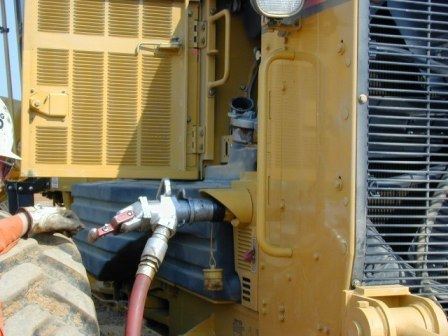 | ||
A Fast fuel system allows speedy refuelling of vehicles. Most large earthmoving and mining vehicles with diesel fuel tanks over 150 US gallons (570 L) are equipped with fast refueling systems. Fast refueling systems utilize an automatic shut off fuel nozzle, receiver and level control device. Fast refuel systems operate by connection of a fill nozzle to the vehicle's fuel tank and a source mounted pump delivers fuel into the tank at rates up to 150 US gallons (570 L) per minute.
Contents
Fast fill systems [1] in general allow for ground level refueling and automatic shut-off upon a full tank. Ground level refueling increases operator safety as climbing onto vehicles during refueling is not necessary as the fill point receiver may be located in a location on the vehicle which is easily accessed.
Pressurized refuel system
Pressurized refuel systems were developed in the 1950s and installed on almost all large vehicles. Caterpillar introduced a non-pressurized refueling system in 1998 on the Caterpillar D11 track type tractor replacing the original pressurized system.
Pressurized refuel systems operate via sealing the fuel tank at the appropriate fill point thus creating internal pressure. The automatic shut off nozzle shuts off when pressure in the fuel system reaches 9 psi (62 kPa) or greater. Due to the pressure introduced into the fuel tank, most tanks require additional structure to prevent bursting or damaged weld joints.
Non-pressurized refuel system
Non-pressure refuel systems operate via a closed loop system where all pressure is contained interior to signal lines, level control, and a shut-off valve. When the fuel tank fill point is reached, a bleed line signal is closed and back pressure is applied to a diaphragm valve at the fuel entry point. Due to differential pressure and an internal spring, the diaphragm is forced closed and cannot be overfilled. Non-pressurized refueling systems do not require tank pressurization for automatic nozzle shut-off, thus allowing their use on thin-walled metallic and composite material fuel tanks.
Non-pressurized refuel systems reduce fuel spills and provided more accurate filling when used with worn automatic refuel nozzles. The system is also designed to prevent overfilling or manual override of the fueling system. David Juleff of Shaw Development, LLC was the design engineer that tailored an aerospace non-pressurized refuel system to be first introduced on the Caterpillar D11 track type tractor in 1998. A number of non pressure fueling systems are available in OEM and retrofit applications from FloMeg, Shaw Delelopment, Hydrau-Flo®, FastFillSystems [2] and others
Non-pressurized refueling systems meet European directive 97/23/EC which permits their use in the European Union as any tank pressurization during refuel is less than 7.3 psi (0.5 bar).
Installation procedures for non-pressurized fast fill systems [3] are documented in Fast Fill Fueling Installation for Off-Road Self-Propelled Work Machines SAE J176. Proper installation is important to maintain operator safety and proper functionality of the system.
Diesel Fast Fill Safety is paramount and discussed in more detail in The Diesel Safety Bulletin
